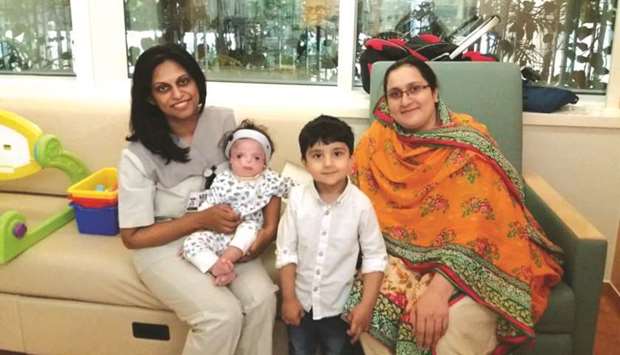
The multidisciplinary paediatric and surgical teams from Sidra Medicine have saved the life of a baby born with multiple life-threatening malformations.
Komail was born with several complex congenital and craniofacial anomalies, such as cleft palate, bilateral microtia (both ears deformed), arrhinia (absence of the nose), and severe micrognathia (undersized jaw) resulting in an upper airway obstruction. After birth, he was immediately transferred to the Neonatal Intensive Care Unit (NICU) at Sidra Medicine.
Komail’s mother Shaista Perveen said, “We were worried for Komail. Never had I felt so alone yet never had I felt so determined. As soon as we stepped through the doors at Sidra Medicine, little were we to know how this hospital and its people would change our lives.”
Dr Helmut D Hummler, division chief, NICU, Sidra Medicine, said, “When Komail first came to the hospital, our multidisciplinary team of specialists immediately set about prioritising a treatment programme to save his life. Complex, multidisciplinary interventions were needed to ensure maximal quality of life.”
Over the course of eight months as an inpatient at Sidra Medicine, Komail underwent multiple life-saving surgeries and procedures while he received round-the-clock care from the NICU team. Komail was on a ventilator for the first six months because of breathing difficulties due to severe upper airway obstruction.
Dr Mitchell Stotland, chief, Plastic and Craniofacial Surgery at Sidra Medicine, said, “Komail’s main issue that needed to be addressed was his inability to move air through his nose and mouth. For Komail, there were two obstructions – first, the fact that he was born without a nose or nasal passages, and secondly, that his lower jaw bone was so severely underdeveloped it was causing his tongue to fall back into his pharynx – that is, right up against the back of his throat. While our colleagues in otolaryngology worked to create a nasal opening to accommodate a breathing tube, we went ahead to lengthen and advance his lower jaw bone enough to bring his tongue forward to help clear his upper airway for spontaneous breathing.”
At four weeks of age, Komail underwent a first procedure in which the bones on both sides of his jaw were cut and an implantable distraction device was inserted which allowed for twice daily lengthening of the jaw bone over a period of a few weeks.
After several months, the device was removed, the jaw was recut, and a second round of jaw advancement was carried out. Approximately 35mm of length was added to Komail’s lower jaw. While this improved the aesthetic balance of his face markedly, the residual underdevelopment of the upper part of his face still made normal breathing too difficult for Komail to maintain.
“We initially remained hopeful that he would be able to breathe properly by himself after the surgical interventions, but it became more and more apparent that he needed to undergo a tracheostomy. This involved making a small surgical opening in his neck to place a tube into his windpipe which would allow him to breathe properly and independently without a ventilator,” said Dr Patrick Sheehan, senior attending physician of otolaryngology, head and neck surgery, Sidra Medicine who performed Komail’s tracheostomy.
Following the tracheostomy, Komail also needed to be fitted with a hearing device as he wasn’t able to hear at normal levels.
After eight months at Sidra Medicine, and with the majority of his treatment complete, Komail was discharged from the hospital.
Perveen acknowledged the support, “My family and I have now relocated to Europe. Our hearts are filled with joy to see how far he has come. He has started crawling. He claps, dances and enjoys music. I am lucky my son survived and to have had a hospital like Sidra Medicine beside me during the most critical time.”
